If you’ve ever researched the strange terminology for animal groups (known as venery), you’ll quickly learn there’s a lot more than just herds and packs. Where did these oddball collective nouns come from? We’ve discovered the origin stories for some of the most interesting animal group names out there. Who knows? One of them might become your next fun fact at a cocktail party.
The history of venery
It wasn’t scientists who coined fanciful and poetic names like a charm of hummingbirds or a cauldron of bats. Rather, 15th-century Englishmen (who were typically wealthy and educated) would come up with names for animal gangs whilst hunting. The terms eventually found their way into books. Although they were never fully adopted by the science community, they've managed to stick around as a unique way to show off your animal knowledge.
Murder of crows
Many examples of venery relate to the physical appearance or traits of the animal group in question. Heavenly doves, for example, have the honor of being referred to as a piteousness of doves. Dark-winged crows, however, had an opposite reputation. Coincidence or not, they’d often appear in cemeteries, on battlefields, or just about anywhere disaster had struck. There’s also a rumored crow parliament where hundreds of birds would gather only to kill off one of their own. That, plus the loud, harsh cry they make when in a pack, lent itself to this less-than-flattering name.
Parliament of owls
While most examples of venery are charming witticisms from centuries ago, this one is much more recent. C.S. Lewis’ classic tales, “The Chronicles of Narnia,” feature a council of owls that meet at night to review the affairs of Narnia. Furthermore, it's a reference to a Geoffrey Chaucer poem titled “Parliament of Foules” (fowls), which was written in the 14th century.
Shrewdness of apes
Given the close connection between humans and primates, you’d be forgiven for thinking this was an adept way to describe a cluster of intelligent monkeys. However, when the term was coined in 1486, shrewdness meant wickedness, which was likely relating to the natural mischievousness of monkeys. Luckily as language has evolved, this name suits clever apes even more astutely.
Bloat of hippopotamuses
Somehow in all the venery crafted over the centuries, poor hippos were left out until 1939, when they were given this rather unfortunate collective noun in a hunting and fishing manual. That’s not to say the name isn’t appropriate. Male hippos can weigh over 7,000 pounds and have a thick layer of subcutaneous fat to help them float and look bloated.
Gaggle of geese
Compared to most terms of venery, this example is a bit more well known due to its sweet alliteration. Given the loud, squawking, honking sounds geese make when clustered in a group, they were given this label to describe their general noisiness.
